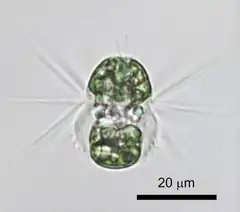| Mesodinium | |
|---|---|
 | |
| Mesodinium species containing green plastids taken from cryptophyte prey[1] | |
| Scientific classification | |
| Domain: | |
| (unranked): | |
| (unranked): | |
| Phylum: | |
| Class: | |
| Order: | Cyclotrichiida |
| Family: | Mesodiniidae |
| Genus: | Mesodinium |
| Species | |
| |
Mesodinium is a genus of ciliates that are widely distributed and are abundant in marine and brackish waters.[2][3] Currently, six marine species of Mesodinium have been described and grouped by nutritional mode: plastidic (M. chamaeleon, M. coatsi, M. major, and M. rubrum) or heterotrophic (M. pulex and M. pupula). There is some debate as to whether the nutritional mode of plastidic Mesodinium species is phototrophic (permanent plastid) or mixotrophic.[4][5] Among the plastidic species, wild M. major and M. rubrum populations possess red plastids belonging to genera Teleaulax, Plagioselmis, and Geminigera,[6][7][8] while wild M. chamaeleon and M. coatsi populations normally contain green plastids.[9][10][11] The availability of suitable cryptophyte prey is important for bloom formation of plastidic Mesodinium species.[1]
The most common species, Mesodinium rubrum, causes red tides in many coastal ecosystems. Although M. rubrum is known as a nontoxic species,[12] blooms of the ciliate can be potentially harmful to aquaculture industries.[13][14][1] M. rubrum photosynthesizes by sequestering the nucleus of its cryptophyte prey, in order to maintain stolen plastids and other organelles.[15] In this way, the genus Mesodinium plays an important role in linking cryptophycean prey and diverse predators in the aquatic microbial food web. For example, the dinoflagellates Dinophysis spp., which are a predator of M. rubrum and the source of their cryptophyte-derived plastids, have been frequently observed to precede or to coincide with high densities of M. rubrum.[16][17][18][19][1]
See also
References
- 1 2 3 4 Nishitani, G. and Yamaguchi, M. (2018) "Seasonal succession of ciliate Mesodinium spp. with red, green, or mixed plastids and their association with cryptophyte prey". Scientific reports, 8(1): 1–9. doi:10.1038/s41598-018-35629-4.
 Material was copied from this source, which is available under a Creative Commons Attribution 4.0 International License.
Material was copied from this source, which is available under a Creative Commons Attribution 4.0 International License. - ↑ Leppanen, J. M. & Bruun, J. E. (1986) The role of pelagic ciliates including the autotrophic Mesodinium rubrum during the spring bloom of 1982 in the open northern Baltic proper. Ophelia 4, 147–157.
- ↑ Sanders, R. W. (1995) Seasonal distributions of the photosynthesizing ciliates Laboea strobila and Myrionecta rubra (=Mesodinium rubrum) in an estuary of the Gulf of Maine. Aquat. Microb. Ecol. 9, 237–242.
- ↑ Qiu, D., Huang, L. & Lin, S. (2016) Cryptophyte farming by symbiotic ciliate host detected in situ. Proc. Natl. Acad. Sci. USA 113, 12208–12213.
- ↑ Johnson, M. D. et al. (2017) Mesodinium rubrum: Te symbiosis that wasn’t. Proc. Natl. Acad. Sci. USA 114, E1040–E1042
- ↑ Nishitani, G. et al. (2010) High-level congruence of Myrionecta rubra prey and Dinophysis species plastid identities as revealed by genetic analyses of isolates from Japanese coastal waters. Appl. Environ. Microbiol. 76, 2791–2798.
- ↑ Herfort, L. et al. (2011) Myrionecta rubra population genetic diversity and its cryptophyte chloroplast specificity in recurrent red tides in the Columbia River estuary. Aquat. Microb. Ecol. 62, 85–97.
- ↑ Herfort, L. et al. (2017) Use of highly specific molecular markers reveals positive correlation between abundances of Mesodinium cf. major and its preferred prey, Teleaulax amphioxeia, during red water blooms in the Columbia River estuary. J. Eukaryot. Microbiol. 64, 740–755.
- ↑ Garcia-Cuetos, L., Moestrup, Ø. & Hansen, P. J. (2012) Studies on the genus Mesodinium II. Ultrastructural and molecular investigations of five marine species help clarifying the taxonomy. J. Eukaryot. Microbiol. 59, 374–400.
- ↑ Moestrup, Ø., Garcia-Cuetos, L., Hansen, P. J. & Fenchel, T. (2012) Studies on the genus Mesodinium I: ultrastructure and description of Mesodinium chamaeleon n. sp., a benthic marine species with green or red chloroplasts. J. Eukaryot. Microbiol. 59, 20–39.
- ↑ Nam, S. W., Shin, W., Kang, M., Yih, W. & Park, M. G. (2015) Ultrastructure and molecular phylogeny of Mesodinium coatsi sp. nov., a benthic marine ciliate. J. Eukaryot. Microbiol. 62, 102–120.
- ↑ Lindholm, T. (1985) Mesodinium rubrum–a unique photosynthetic ciliate. Adv. Aquat. Microbiol. 3, 1–48.
- ↑ Hayes, G. C., Purdie, D. A. & Williams, J. A. (1989) The distribution of ichthyoplankton in Southampton Water in response to low oxygen levels produced by a Mesodinium rubrum bloom. J. Fish Biol. 34, 811–813.
- ↑ Liu, H. et al. (2012) Potential risk of Mesodinium rubrum bloom in the aquaculture area of Dapeng’ao cove, China: diurnal changes in the ciliate community structure in the surface water. Oceanologia 54, 109–117.
- ↑ Johnson, M. D., Oldach, D., Delwiche, C. F. & Stoecker, D. K. (2007) Retention of transcriptionally active cryptophyte nuclei by the ciliate Myrionecta rubra. Nature 445, 426–428.
- ↑ Mouritsen, L. T. & Richardson, K. (2003) Vertical microscale patchiness in nano- and microplankton distributions in a stratifed estuary. J. Plankton Res. 25, 783–797.
- ↑ Sjöqvist, C. O. & Lindholm, T. J. (2011) Natural co-occurrence of Dinophysis acuminata (Dinoflagellata) and Mesodinium rubrum (Ciliophora) in thin layers in a coastal inlet. J. Eukaryot. Microbiol. 58, 365–372.
- ↑ Lips, U. & Lips, I. (2014) Bimodal distribution patterns of motile phytoplankton in relation to physical processes and stratification (Gulf of Finland, Baltic Sea). Deep-Sea Res. II. 101, 107–119.
- ↑ Velo-Suárez, L., González-Gil, S., Pazos, Y. & Reguera, B. (2014) The growth season of Dinophysis acuminata in an upwelling system embayment: a conceptual model based on in situ measurements. Deep-Sea Res. II 101, 141–151.